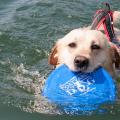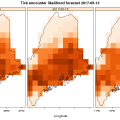DMR is keeping an eye on toxic bloom in Casco Bay
Tuesday, September 26th 2017

An extensive bloom of the phytoplankton Karenia mikimotoi in the Casco Bay region is being monitored by the Maine Department of Marine Resources.
Unlike other toxic blooms that DMR routinely monitors, including those that cause paralytic shellfish poisoning and amnesic shellfish poisoning, this species of phytoplankton is not a threat to human health, according to DMR. However, the species can have harmful effects on finfish and shellfish and other marine organisms.
There have been fish mortality events reported during blooms of this species in Hong Kong, Australia, Ireland, Japan, Korea and Alaska.
The toxicity of Karenia mikimotoi is not fully understood, however is believed that associated mortality events are due to a combination of an anoxic environment (low oxygen) created by the physical bloom itself in addition to some sort of toxin that affects finfish and shellfish.
“We are not able to predict if a low oxygen event will occur or if the toxins it is known to produce will impact fish or shellfish,” said Maine DMR Public Health Bureau Director Kohl Kanwit. “We have been working with Dr. Kate Hubbard, a research scientist with the Florida Fish and Wildlife Conservation Commission who has extensive experience with Karenia mikimotoi, to gain a better understanding of this species of phytoplankton.
“We will continue to work closely with Dr. Hubbard and partners at Bigelow Laboratory for Ocean Sciences, Kennebec River Biosciences, and NOAA to gain insight into this new species of phytoplankton and its affects on fish and shellfish,” said Kanwit.
The department has reached out to the shellfish industry, aquaculture lease holders, lobster dealers and shellfish dealers in the Casco Bay region informing them of the bloom and advising them to develop plans to protect their product if they observe effects of low oxygen or toxins. The department has received preliminary reports of softshell clam mortality events in Brunswick, Freeport and Harpswell and is working to confirm the cause and extent of these mortality events.
The department will continue to test water in the Casco Bay region for dissolved oxygen levels and for the presence of Karenia mikimotoi. Anyone who observes a mortality event involving marine organisms is encouraged to report it to a Marine Patrol Officer. Contact information can be found at http://www.maine.gov/dmr/marine-patrol/marine-contact.html.
















